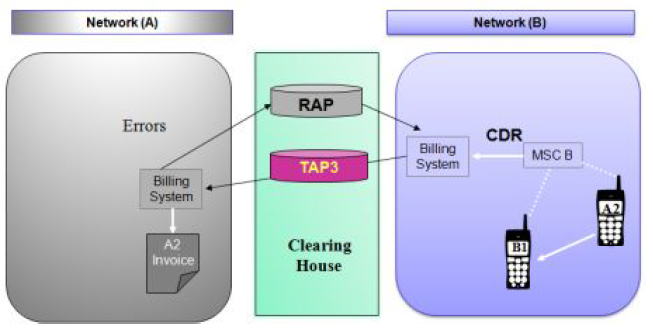Roaming is the ability for a customer of mobile communications to automatically make and receive telephone calls, send and receive data, or access other services while travelling outside the geographical coverage area of the home network, by means of using a network of another operator.
Roaming can be either national roaming or international roaming . National roaming means that mobile
subscribers make use of another network in geographical areas, where their own operator does not have
coverage. T his is, e.g ., used by operators, who do not have complete coverage in a country. International
roaming is used when mobile subscribers travel abroad and make use of the network of an operator in the
foreign country.

How actually it happens? Yes, if a service provider does not have a network coverage in a particular city or
country, then this service provider makes a roaming agreement with another service provider having network in that city or country. As per this agreement, another service provider provides all the available services to the roaming customer of first service provider.
CDRs generated in one roaming partner's area are collected and rated by that roaming partner and finally they are sent to the actual service provider of the roaming customer. Actual service provider charges the end customer for all the roaming services provided based on their predefined service charges.
Two roaming partners settle their financials on monthly basis by exchanging actual roaming CDRs and reports based on those CDRs.
HPMN and VPMN:
The Home Public Mobile Network is the network from the operator by which a mobile subscriber has a
subscription. The term is used as opposed to Visited Public Mobile Network (VPMN).
The Visited Public Mobile Network is the network used by a mobile subscriber while roaming . The term is used as opposed to Home Public Mobile Network (HPMN).
Clearing House:
There are well known bodies like MACH who interface between different roaming partners to help them to
exchange their CDRs, setting up roaming agreements and resolving any dispute.
Clearing houses receive billing records from one roaming partner for the inbound roamers and submit billing records to another roaming partner for which this roamer would be called outbound roamer.
What is TAP3?
Transferred Account Procedure version 3 (TAP3) is the process that allows a visited network operator (VPMN) to send billing records of roaming subscribers to their respective home network operator (HPMN). TAP3 is the latest version of the standard and will enable billing for a host of new services that networks intend to offer their customers.
Clearing house uses TAP3 protocol to exchange all the CDRs between different roaming partners. TAP3
defines how and what information on roamed usage must be passed between Network Operators. These files are exchanged using simple FT P connection.
There are different versions of TAP. TAP evolved from TAP1 throug h TAP2 and TAP2+ to TAP3. The latest release, TAP3, includes support for inter-standard roaming in a satellite network, WLAN and UMTS and other 3G technologies.
GSM TAP Standard T D.5 7: GSM Transferred Account Procedure (T AP) defines the format and
validation rules for transferring roaming usage information between mobile operators in different
countries. TAP3 is the third specification version of the standard. T he files transferred are termed TAP
files.
GSM RAP Standard T D.3 2: GSM Returned Accounts Procedure (RAP) defines the format for
returning information on errors found within transferred T AP files/events and thereby rejecting financial
liability for those files/events. T he files transferred are termed RAP files.
Roaming Billing :
Mobile subscriber travels to another country and creates usage on the foreign network. In order to bill the
subscriber, this information has to be passed back to the subscriber's home network. T he foreign network will collect information on the usage from it's switches, etc., and then create T AP files containing the information set out in the standard.
The files are then EXPORTED (on a regular basis, generally at least one file per day) to the home operator, who will IMPORT them and then use the information to invoice the subscriber. T he foreign operator will rate the calls and then charge the subscribers home network for all the calls within a file. T he home operator can mark up or re-rate the calls in order to make revenue.
